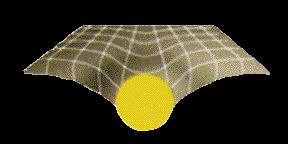 source:
http://imagine.gsfc.nasa.gov/docs/features/topics/
see
also here
source:
http://imagine.gsfc.nasa.gov/docs/features/topics/
see
also here
Who invented it or sound the mort to redefine history
Already in 1969 I discussed the general idea with different people. The article in the astronomic journal "Sterne und Weltraum" 5/88 S.324: "Die durch den Planetenumlauf erzeugte Bahn der Sonne" made my ideas known to the whole world. In 1991 I informed our leading german astrophysics institutes of our wobbling sun and the consequences thereof. In Oct. 1995 the first exoplanet was found.
The race is open to redefine history... Everyone has its own story to tell who was at the origin of the extrasolar planet hunt. Here only some examples.
The negative side of Wikipedia shows up here, that everyone can define its own history. Wikipedia in whole is used extensively in this case to produce false tracks and false historic facts. Another example. There are so many and everyday a new one is added so that it seems not necesary to care about.
But the web in whole is used to redefine history. Only some excerpts out of this "redefinition bussiness" :
Another article (Nature! Incredibly. They take part in this game. The links are rather dead) The referenced article is from 1992, not 1991. A naiv question: Is a pulsar a normal star like our sun ?
Another (click on more info..)
Another (Compare this with this description!)
Seems everyone has some other dates to tell.
Besides articles everyone produces these days graphs (seems these folks think that it looks impressively scientific) with exoplanet discoveries in 1988 or even as early as the fiftheeths or lists in which suddenly exoplanets apear which you don't find in any other list and so on... The bending of historic facts has many aspects.
In the list Compiled by California and Carnegie Planet Search you can find one single entry predating my letters and postings: HD 114762b, which is till today (Dec of 2009) not confirmed as an exoplanet (it seems to be a brown dwarf):
"If it turns out to be an exoplanet, it will be the first one ever detected...." . (eg Wikipedia HD 114762b ) Strange kind of science, why not list some other, even earlier found as "exoplanet, to be confirmed". And as you can read on this whole site, all stars will get confirmed as having exoplanets! Tip: use any star ever detected.
Just for the record this is of end of 2011: "HD 114762 b is a candidate extrasolar planet, approximately 132 light years away in the constellation of Coma Berenices, and is probably a brown dwarf. This optically undetected companion to the late F-type star HD 114762 was discovered in 1989 by David Latham and others.[2] As of 2006, insufficient confirmed measurements exist to determine whether it is a high mass gas giant, with its lowest possible mass being 11 times the mass of Jupiter, brown dwarf, or a red dwarf with its highest mass around 145 times Jupiter. If it does turn out to be an exoplanet it will be the first one ever detected - although not confirmed - predating the 1992 pulsar planets found around PSR B1257+12 and main-sequence yellow dwarf 51 Pegasi.[3][4] It orbits the star around 83.89 days and an orbital eccentricity of 0.34." Again this is a local copy since wikipedia changes every other day.
Those who publish such lists obviously want to tell us that it takes the "New York Times" nearly ten years to report a sensational news fact or that SETI and "The Planetary Society" and Geoffrey Marcy and ...(see citations on index page of this site) do not know their job.
(And if there should be any doubt: I got hundreds more citations as local copies)
Afterwards there will come very intelligent people and ask: " why haven't you pubished in a scientific magazine?". Very simple. None would have accepted it (and none has accepted it.). A breakdown of a whole part of a science building is unprecedented and simply not conceivable for most of us, editors of science magazines included. And if you don't believe me: there are many serious scientists in the net who tell that Einstein would have had no chance to publish his ideas today!
1) As you can clearly see the sun in this NASA picture of 2011 is still the barycenter of our solar system .
 source:
http://imagine.gsfc.nasa.gov/docs/features/topics/
see
also here
source:
http://imagine.gsfc.nasa.gov/docs/features/topics/
see
also here
"Illustration showing the affect the mass of the Sun has on spacetime."
"Imagine pulling a sheet taut and placing a bowling ball in the center of it; you will notice that the ball produces a curve in the sheet. The curve is weak far away from the ball, and steeper near the ball. In fact, the sheet is a bit stretched in that area near the ball, as well. This situation describes the curvature of spacetime, and how it is affected by mass. Near a mass, spacetime curves more drastically and stretches. Near a very large mass, the 'dent' in spacetime is very deep, and the stretches are near the breaking point. This means that since spacetime stretches near a mass, not only is space stretched out, but so is time." ( http://imagine.gsfc.nasa.gov/docs/features/topics/).